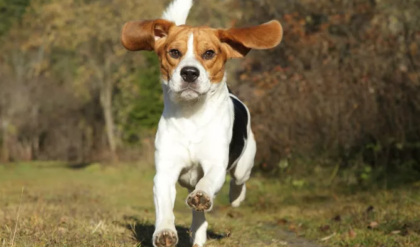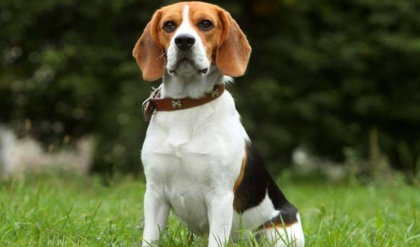Dogs have been our loyal companions for centuries, and two breeds that have captured the hearts of many pet owners are the Beagle and the Foxhound. These breeds have distinct characteristics that make them unique, and choosing between them can be a daunting task. In this comprehensive article, we will delve into the details of these beloved canines, exploring their personalities, sizes, grooming needs, training requirements, and exercise demands. By the end, you’ll have a better understanding of which breed is the right fit for your lifestyle and preferences.

Personality Traits: Friendly Beagles vs. Calm Foxhounds
The Beagle: A Bundle of Friendly Mischief
Beagles are known for their friendly and sociable personalities, making them excellent family pets. They are curious and playful, often getting into mischievous situations due to their inquisitive nature. Beagles thrive on human companionship and love being a part of the family.
Affectionate and Loyal
Beagles form strong bonds with their owners and are incredibly affectionate. They crave attention and love being around people, making them great companions for those seeking a devoted and loyal furry friend.
Playful and Energetic
With their high energy levels, Beagles are always up for a game of fetch or a long walk. They have a playful spirit that can bring joy and laughter to any household.
Stubborn and Determined
While their mischievous nature can be endearing, Beagles can also be stubborn and determined when following their noses. This trait makes them challenging to train but also adds to their charming personalities.
The Foxhound: Calm and Independent
Foxhounds are known for their calm and easygoing temperaments. They are independent and can be content spending time alone, making them suitable for households where family members are away for extended periods.
Gentle and Affectionate
Despite their independent nature, Foxhounds are gentle and affectionate with their families. They form strong bonds with their owners and enjoy spending quality time together.
Patient and Adaptable
Foxhounds are patient and adaptable, making them excellent companions for families with children. Their calm demeanor allows them to handle household chaos with grace.
Determined and Focused
Originally bred for hunting, Foxhounds have a strong prey drive and can be determined and focused when on a trail. This trait can make them challenging to train but also showcases their intelligence and persistence.
Size Matters: Small Beagles vs. Large Foxhounds
One of the most significant differences between Beagles and Foxhounds is their size. Beagles are considered small dogs, typically weighing between 20 and 25 pounds and standing 13 to 15 inches tall. On the other hand, Foxhounds are large breeds, weighing between 65 and 75 pounds and standing 21 to 25 inches tall.
This size difference can impact various aspects of owning these breeds, including:
- Living Space: Foxhounds require more living space due to their larger size, while Beagles can adapt to smaller living quarters.
- Exercise Needs: Larger breeds like Foxhounds generally require more exercise and space to run and play.
- Grooming: While both breeds have short, thick coats, the larger size of Foxhounds may mean more shedding and a need for more frequent grooming.
- Cost of Ownership: Larger dogs typically require more food, larger crates, and more substantial supplies, resulting in higher ownership costs.
It’s essential to consider your living situation, lifestyle, and budget when choosing between a Beagle and a Foxhound based on their size.
Grooming Needs: Low-Maintenance Coats
Both Beagles and Foxhounds have short, thick coats that require minimal grooming. Regular brushing is recommended to remove loose hair and distribute natural oils throughout their coats.
Beagle Grooming
Beagles have a dense, weather-resistant double coat that sheds moderately throughout the year. To maintain their coat’s healthy appearance, weekly brushing with a slicker brush or a bristle brush is recommended.
Bathing
Beagles don’t require frequent bathing unless they get particularly dirty or develop an unpleasant odor. Using a mild, dog-safe shampoo and thoroughly drying their coat after bathing is crucial.
Nail Trimming
Regular nail trimming is essential for Beagles to prevent overgrowth and potential discomfort or injury. Trimming their nails every 4-6 weeks is recommended.
Ear Care
Beagles are prone to ear infections due to their floppy ears, which can trap moisture and debris. Regularly cleaning their ears with a dog-safe ear cleaner can help prevent infections.
Foxhound Grooming
Foxhounds have a smooth, short coat that is easy to maintain. Weekly brushing with a bristle brush or a grooming glove can help remove loose hair and keep their coat looking shiny and healthy.
Bathing
Foxhounds don’t require frequent bathing unless they get particularly dirty or develop an unpleasant odor. Using a mild, dog-safe shampoo and thoroughly drying their coat after bathing is crucial.
Nail Trimming
Regular nail trimming is essential for Foxhounds to prevent overgrowth and potential discomfort or injury. Trimming their nails every 4-6 weeks is recommended.
Ear Care
Foxhounds have floppy ears, which can trap moisture and debris, leading to ear infections. Regularly cleaning their ears with a dog-safe ear cleaner can help prevent infections.
Both breeds are relatively low-maintenance when it comes to grooming, making them suitable for pet owners who prefer less grooming time and effort.
Training Challenges: Patience and Consistency
While both Beagles and Foxhounds are intelligent breeds, they can present unique training challenges that require patience and consistency from their owners.
Training the Beagle
Beagles are known for their playful and stubborn nature, which can make training a bit more challenging. However, with the right approach, they can be trained successfully.
Positive Reinforcement
Beagles respond well to positive reinforcement training methods, such as using treats, praise, and rewards for desired behaviors. This approach can help keep them motivated and engaged during training sessions.
Consistency and Patience
Consistency and patience are key when training a Beagle. Their stubborn streak means they may not always listen or follow commands immediately. Staying calm and persistent is essential.
Early Socialization
Beagles benefit greatly from early socialization, as it helps them become well-adjusted and confident in various situations. Exposing them to different environments, people, and animals from a young age can make training easier.
Training the Foxhound
Foxhounds were originally bred for hunting and can be independent and strong-willed, which can present challenges during training. However, with a firm and consistent approach, they can be trained effectively.
Firm and Consistent Training
Foxhounds respond best to firm and consistent training methods. They require a confident and assertive trainer who can establish clear boundaries and expectations.
Positive Reinforcement
While firmness is essential, positive reinforcement techniques, such as treats and praise, can also be effective in motivating Foxhounds during training sessions.
Mental Stimulation
Foxhounds thrive on mental stimulation, so incorporating problem-solving exercises and challenges into their training can help keep them engaged and focused.
Both breeds require patience, consistency, and a tailored approach to training. Working with a professional dog trainer or attending obedience classes can be beneficial, especially for first-time owners.
Exercise Needs: High Energy vs. Rigorous Activity
Exercise is a crucial aspect of owning any dog, and Beagles and Foxhounds have different exercise requirements due to their distinct origins and energy levels.
Beagle Exercise Needs
Beagles are high-energy dogs that require daily exercise and playtime to burn off their excess energy and prevent destructive behaviors.
Daily Walks
Beagles should be taken on at least one or two long walks per day, lasting 30-60 minutes each. These walks provide physical exercise and mental stimulation as they explore new sights and smells.
Playtime
In addition to walks, Beagles benefit from regular playtime sessions. Games like fetch, tug-of-war, or interactive toys can help them burn off energy and stay mentally engaged.
Outdoor Activities
Beagles enjoy outdoor activities such as hiking, swimming, or playing in a fenced yard. These activities provide both physical exercise and mental stimulation, satisfying their curious and active nature.
Foxhound Exercise Needs
Foxhounds were originally bred for hunting, so they have a high energy level and require rigorous physical activity to stay healthy and happy.
Long Runs
Foxhounds excel at running and have impressive endurance. They benefit from long runs or jogs alongside their owners to satisfy their need for physical exercise and mental stimulation.
Obedience Training
Engaging in obedience training activities with Foxhounds, such as agility courses or scent work, can provide them with both physical and mental challenges. These activities help channel their energy in a positive way.
Mental Stimulation
In addition to physical exercise, Foxhounds require mental stimulation to prevent boredom and destructive behaviors. Puzzle toys, interactive games, and training sessions can keep their minds sharp and engaged.
Hunting Simulations
Since Foxhounds have a strong hunting instinct, engaging in activities that simulate hunting behavior, such as scent tracking or hide-and-seek games, can be beneficial for their overall well-being.
Both Beagles and Foxhounds thrive on regular exercise and mental stimulation, but the intensity and type of activities may vary based on their individual needs and energy levels.
Living Space Requirements: Adaptability and Size Considerations
When choosing between a Beagle and a Foxhound, it’s essential to consider their living space requirements to ensure they are comfortable and happy in their environment.
Beagle Living Space Needs
Beagles are adaptable dogs that can adjust well to various living situations, including apartments, provided they receive enough exercise and mental stimulation.
| Living Space | Description |
|---|---|
| Apartments | Beagles can live in apartments as long as they receive daily walks and playtime to expend their energy. Access to a fenced yard or nearby park is beneficial. |
| Houses with Yards | Beagles thrive in houses with yards where they can explore and play freely. A secure fence is necessary to prevent them from wandering off due to their curious nature. |
| Indoor Space | Beagles enjoy indoor spaces with cozy beds and toys to keep them entertained. They should have access to windows for observing outdoor activities. |
Foxhound Living Space Needs
Foxhounds are larger dogs that require more space to move around comfortably, making them better suited for homes with ample room both indoors and outdoors.
- Houses with Large Yards: Foxhounds do well in houses with large, securely fenced yards where they can run and play freely. The size of the yard should accommodate their active nature.
- Rural Settings: Foxhounds thrive in rural settings where they have access to open spaces for running and exploring. Living in the countryside or suburbs with nearby trails is ideal for them.
- Climate Considerations: Foxhounds may struggle in extreme climates due to their short coat and low body fat. Providing shelter and appropriate bedding is crucial in cold weather.
While Beagles can adapt to smaller living quarters with sufficient exercise and mental stimulation, Foxhounds are better suited for homes with more space to accommodate their size and energy levels.
Cost of Ownership: Budgeting for Essentials
Owning a dog comes with various expenses, including food, grooming, veterinary care, and supplies. Both Beagles and Foxhounds have specific needs that can impact the overall cost of ownership.
Beagle Ownership Costs
Beagles are generally considered affordable to own, but potential owners should budget for essential expenses to ensure their well-being and happiness.
- Food and Treats: Beagles require high-quality dog food to meet their nutritional needs. Treats for training and dental health should also be included in the budget.
- Veterinary Care: Routine veterinary visits for vaccinations, check-ups, and preventive care are essential for Beagles. Emergency medical expenses should also be factored into the budget.
- Grooming Supplies: While Beagles have low-maintenance coats, grooming supplies such as brushes, nail clippers, and ear cleaners are necessary for their care.
- Training Classes: Investing in obedience training classes or private sessions can help address behavioral issues and ensure a well-behaved Beagle.
- Toys and Enrichment: Beagles are playful dogs that benefit from toys and enrichment activities to prevent boredom and destructive behaviors.
Foxhound Ownership Costs
Foxhounds may be more expensive to own due to their larger size and specific needs that require financial planning and budgeting.
- Food and Supplements: Foxhounds require a larger quantity of food to meet their energy needs. High-quality dog food and supplements may be necessary for their overall health.
- Veterinary Expenses: Regular veterinary care, including vaccinations, spaying/neutering, and parasite prevention, should be budgeted for Foxhounds. Emergency medical care can be costly due to their size.
- Grooming Services: While Foxhounds have short coats, professional grooming services may be required for occasional baths, nail trimming, and ear cleaning.
- Exercise Equipment: Foxhounds benefit from exercise equipment such as leashes, harnesses, and toys to engage in physical activities and prevent boredom.
- Insurance and Contingency Fund: Setting aside funds for pet insurance and unexpected medical expenses is advisable for Foxhound owners.
Considering the long-term costs of owning a Beagle or a Foxhound is crucial for budget-conscious individuals to provide proper care and support for their furry companions.
Conclusion
In conclusion, choosing between a Beagle and a Foxhound involves considering various factors such as grooming needs, training challenges, exercise requirements, living space considerations, and the cost of ownership. While both breeds share similarities in terms of coat maintenance and training approaches, they differ significantly in size, energy levels, and living space preferences.
Beagles are well-suited for individuals or families living in smaller quarters, looking for a low-maintenance companion with moderate exercise needs. Their adaptability and friendly nature make them popular choices for first-time dog owners.
On the other hand, Foxhounds are better suited for owners with larger living spaces and an active lifestyle. Their high energy levels, rigorous exercise requirements, and independent nature make them ideal for experienced dog owners who enjoy outdoor activities and have the time and resources to meet their needs.
Ultimately, the decision between a Beagle and a Foxhound should align with your living situation, activity level, grooming preferences, training capabilities, and budget constraints. Both breeds can make loving and loyal pets when provided with proper care, attention, and a nurturing environment tailored to their unique characteristics and requirements.






